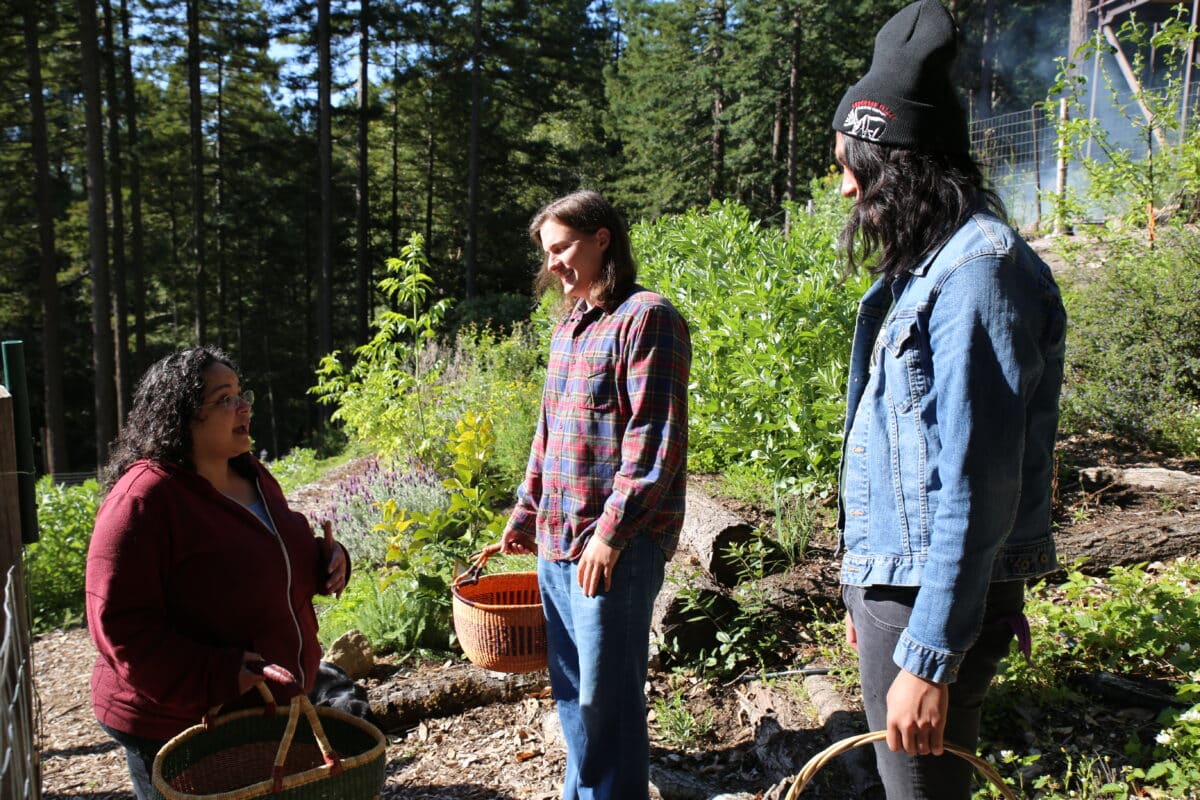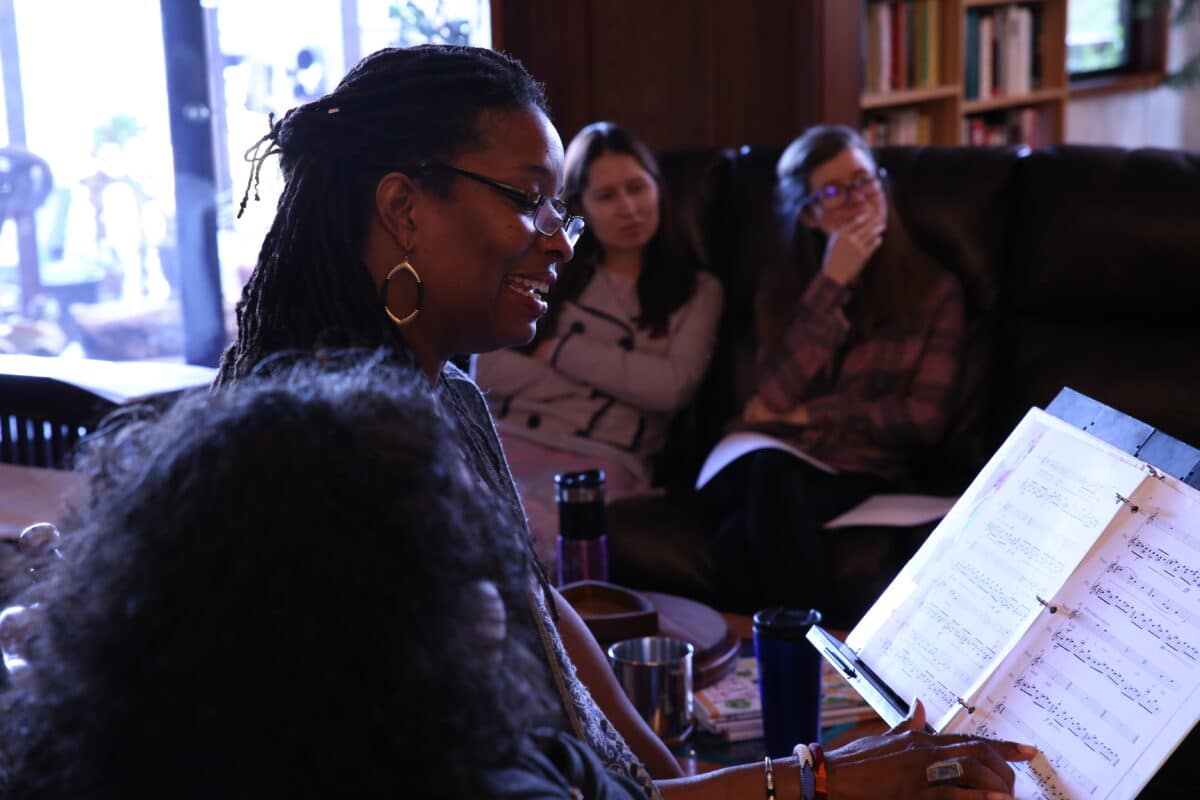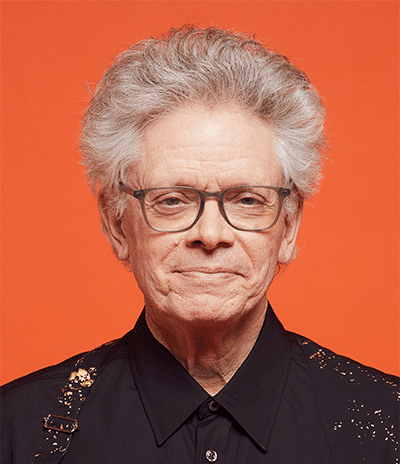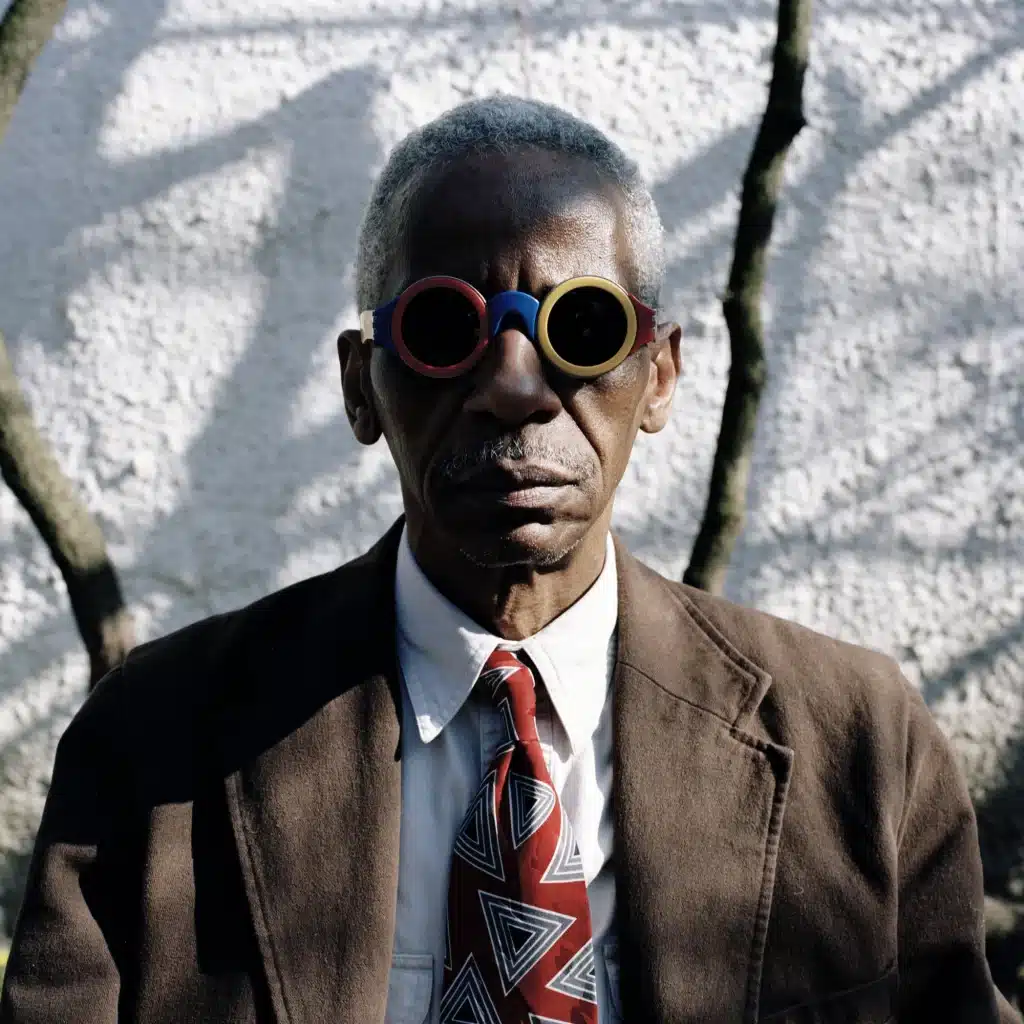Life Lessons
Inside Gabriela Lena Frank’s innovative composer academy.

Gabriela Lena Frank has a theory about why some contemporary classical compositions soar and others sink. And she built an entire school around it.
“I believe that at least half of the so-called unsuccessful compositions out there only miss the mark by a little bit,” said Frank, who has 92 completed works listed on her resume, many commissioned by esteemed soloists and ensembles.
A composer might have assigned the wrong line to the wrong instrument, or built a crescendo that didn’t quite move the crowd—small mistakes, that in Frank’s view, could have been fixed with a simple tool: a reading prior to the premiere where the writer could get feedback from other composers and musicians. Readings of pieces in development are standard practice for folks who create stage plays and operas, but not for composers who work on the instrumental side of chamber and orchestral music.
“The industry isn’t set up for that. Composers just show up at rehearsal,” she said. “So you either write something that’s safe or you take a big risk—and that may or may not work out.”
And so readings are at the heart of the Gabriela Lena Frank Creative Academy of Music, where emerging composers gather to learn, play, write, and share, but also to listen to each other’s music and to the candid criticism of their mentors.
The academy, which opened publicly March of 2017, is structured—but only to a point. Composers attend in overlapping cycles of six of seven students and they must be interested in working in the classical or classical-crossover medium. The program is essentially a year-long apprenticeship that starts with Skype consultations and an initial four-day residency where participants hone their professional practice and generate the core of a new composition to be written for a specific string quartet or other musical ensemble.
They return six months later for a three-day session where the musicians perform the finessed composition at the academy’s public concert series, titled the Bueno Yabbelow Music Series.
Even so, the Gabriela Lena Frank Creative Academy is powered by informality. It takes place at Frank’s home, a large and open farm in rural Boonville, California—a “tiny wine town with rustic charm,” as Frank describes it. Students lodge together, they eat as a group, and even help prepare meals.
“I do put them to work,” says Frank. “We collect eggs from our chickens, we go foraging in the garden for the food we’re going to eat.”
The close quarters forge bonds, which become trusting circles, which—hopefully—become lasting professional networks. The students also get a mentor in Frank. She invites them into her home where she lives with her husband and dogs, but also shares ideas about living a well-rounded, artistic life, full of creative achievement, community service and a meaningful place in the world beyond music.

Gabriela Lena Frank had plenty of chances to become a teacher, and she’s comfortable in the world of universities and conservatories. Her father, a Mark Twain scholar at the University of California, Berkeley, began nudging her toward academia the day she started kindergarten.
She earned one, of course—in composition, from the University of Michigan in 2001—and got her first offer to become a professor. She turned it down, choosing to compose full-time. “I knew by doing, I was going to grow,” she said.
She then set off to explore the world, and her own heritage. The daughter of a Peruvian-Chinese mother and a Lithuanian-Jewish father, she decided to examine her maternal roots with extended visits to South America. There, she discovered folkloric traditions that would change her music forever.
Frank is known for her contemporary compositions—think Bartok, if he wrote in the global village we live in today. She has succeeded most notably, as her publisher G. Schirmer puts it in her official biography, by incorporating South American “poetry, mythology, and native musical styles into a western classical framework that is uniquely her own.”
“I wasn’t born in Peru, I was born here. English is my first language,” she said. “So, I go at it with a sense of wonder.”
Frank has faced career-roadblocks of her own. Early on, just as she began receiving commissions, she found herself with a disease that weakened her immune system. She suffered with it for seven years, composing what she could through what was, at times, a life-threatening illness.
“It made me make choices. I wasn’t going to take on things that weren’t really meaningful and impactful,” she said.
That deliberateness guided her through her recovery, and ever since. “You have to be strategic about how you produce, so you don’t burn out,” she said.
Frank calls herself “a chamber music composer at heart,” but she’s also been in demand for larger ensembles, producing commissions for the Chicago Symphony Orchestra, San Francisco Symphony, and others. She recently served as composer-in residence with both the Detroit Symphony and the Houston Symphony, and will assume that position next with the Philadelphia Orchestra. She’s won accolades and awards, including a Guggenheim Fellowship and a $50,000 grant from United States Artists. And, unsurprisingly, there have been other offers from universities to join the faculty.
“I’ve been courted by universities, but they couldn’t quite give me what I felt was going to help me have the largest impact,” she said. “Some of those offers were good. I had to be really strong.”
Frank has also prospered in a composing field that is dominated by men, and nearly all of European descent. Her ethnic background has both helped and hurt, she believes. She has been passed up and tokenized because she is different. But her differences have also sparked creativity and allowed her to express alternative viewpoints.
Her life has been full, she said, of unexpected turns, and she’s tried to utilize them all to inform her art. “The last unexpected thing was marrying a mountain guy and moving to the country.”
But there she was, a few years back, on all those acres in Boonville, surround by animals and trees and the lushness of nature. She found herself grounded, nurtured, accomplished, lucky.
Gabriela Lena Frank was finally ready to teach.

Frank started formulating the idea for her academy during a mid-2016 road trip to the Music from Angel Fire festival in northern New Mexico. She was feeling the conservative political tide that was sweeping the vast tracks of land on her route, sensing that artists and people of color were being pushed farther out of the mainstream. Starting the school would be her way of taking action.
From a career perspective, the timing was all wrong. “It was my busiest professional year ever. I was barely hanging on. I had three gargantuan orchestral premieres, one of them at Carnegie Hall, one of them a full-blown requiem.”
Still, she sent out invites to emerging composers she’d encountered. One went to Nina Shekhar, a flutist studying at the University of Michigan.
The invitation alone was a motivator for Shekhar. “I always thought maybe I wouldn’t fit into the musical world as an Indian-American,” she said. “But having someone like Gabby, who is a woman of color, invite me, gave me such validation.”
Shekhar, then 21, joined five other fellows from different backgrounds and geographies. What they all had in common was Frank’s eagerness and enthusiasm to move their music forward.
In between the egg-collecting, the foraging, and the coaching, the students ultimate assignment was to write a piece for a guest faculty that included the Third Angle New Music Ensemble and soprano Tony Arnold, who worked with them during their stay.
Composers found different ways to express themselves. One wrote a lullaby for his son; another created a setting for poetry by Langston Hughes. Shekhar dug deep, penning a nine-minute piece called Quirkhead, about her experiences with obsessive-compulsive disorder.
The subject was deeply personal, something Shekhar had never talked about publicly. But the setting—with Frank guiding, the musicians helping to create a language, the other fellows churning—enabled her to open up.
So far, the academy has completed three cycles with 19 composers; another four are in currently progress, with 26 students enrolled. Four more cycles are scheduled, with guest faculty already lined up.
Students are now admitted by application, with Frank making decisions after vigorously poring over written work and recordings, as well as candidates’ letters explaining their musical philosophies. There are no official rules, and every decision is personal. “I’m not at all impressed by fancy resumes,” she said. “I’m a bit like a private teacher taking students into her studio.”
That open-minded policy has allowed her accept students from across the globe, some of whom who don’t even have all the basic music writing or notation skills, though they must be willing to pick those up.
“My staff and I are a small enterprise and already my academy is more diverse than most orchestras and conservatories,” she said.
That’s not just about race and ethnicity, but also musical and personal styles.
Matthew Evan Taylor is a classical composer with a strong background in both jazz and rock music. He took part in last year’s cycle three. Taylor brought something different to the table and found others who also had their own unique stories.
“I’ve generally felt out of place in my whole life for a myriad of reasons, whether that was being Black or being the smartest kid in class or not being interested in the things that everybody else was interested in.”
At the academy everybody fit in naturally. “As composers we all tend to be outsiders,” he said.
Taylor said the academy propelled him forward in multiple ways, including helping him build a richer professional network. Already, he has been able to connect himself—and academy peers—with new commissions.
Frank wants to enable more of that—first and foremost, by making it as easy as possible for students to attend the Academy. Tuition is $1,950, and students have to get themselves to Boonville. But there’s plenty of help available, with financial aid averaging 75% plus travel assistance.
Second, she’s building an alumni support system to help ensure that fellows go on to receive actual commissions. In June, the academy announced several, including five co-commissions with the Orchestra of St. Luke’s, for works that will be part of Carnegie Hall’s upcoming series Migrations: The Making of America.
There will also be a two-year apprenticeship program, where academy alumni can continue to receive readings of new works with the Eastern Sierra Symphony; plus new micro-grants, that will encourage alumni across different cycles to collaborate with one another.

There’s one more aspect to the Gabriela Lena Frank Academy that shapes the way it operates, and that is its connection to the local community. Students interact with residents of the surrounding Anderson Valley, a mix of ethnicities and incomes, through performances and coaching.
Frank sets the pace for this herself. She volunteers at a local school, teaching music to “the sons and daughters of Latino vineyard farm workers.” It’s a serious endeavor: this year her mentoring culminated with a concert in the school cafeteria where the Del Sol String Quartet premiered seventeen string quartets.
Frank does her part to make sure the topic of community involvement stays on the table as her own students cycle in and out of the academy. She knows they’re focused on their own ambitions, but she’s learned that commissions come and go, along with ideas of self-worth, and that stepping outside of the contemporary music bubble help keeps the passion going.
“You need to be an arts citizen. You can’t operate in this narrow lane,” she said. “You need to look at your impact in the wider community and this is where you’ll have a sustainable life.”



